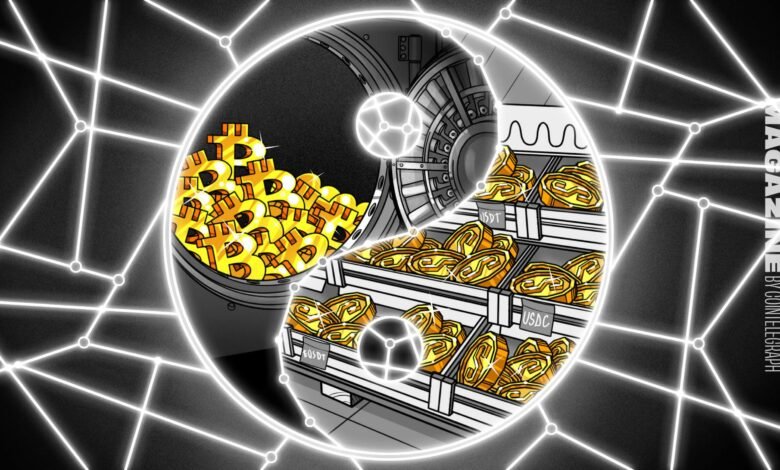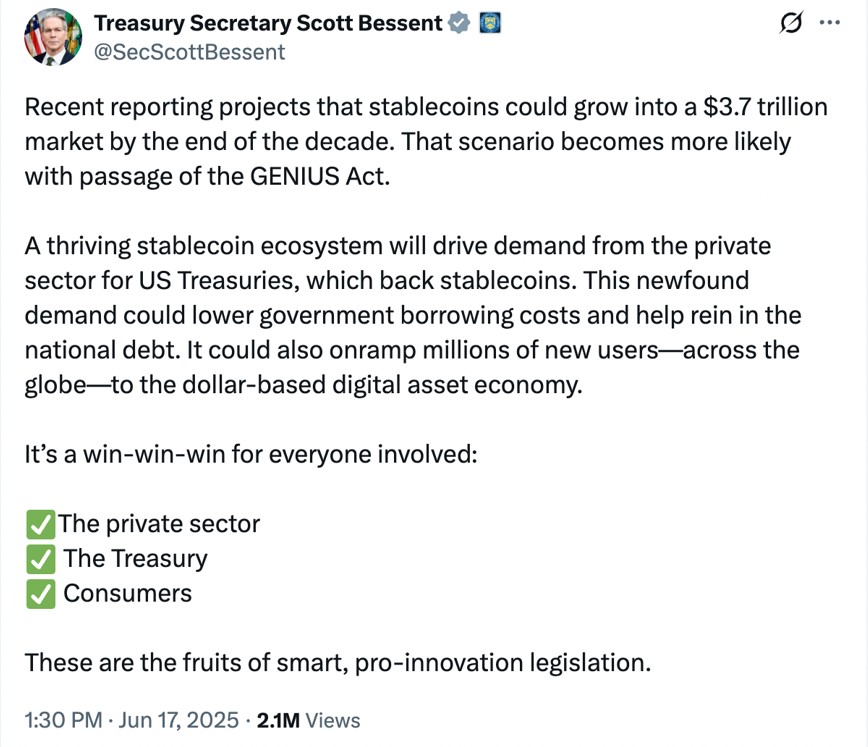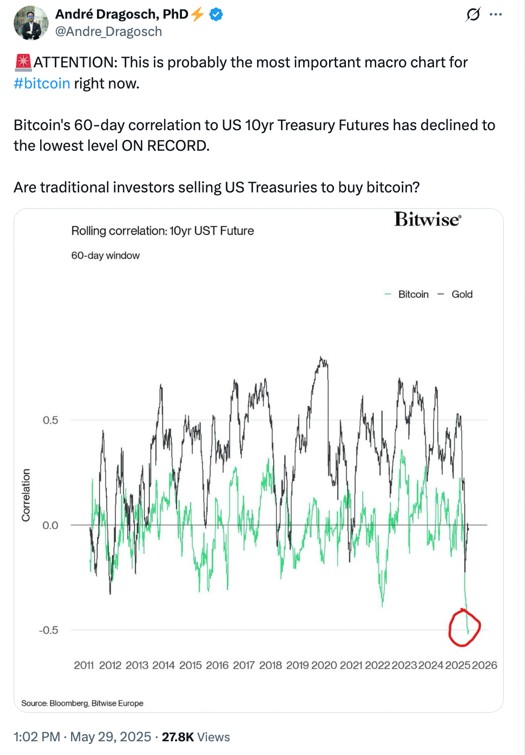Bitcoin Vs. Stablecoins showdown looms as GENIUS Act nears

There’s been an unprecedented tailwind in Washington DC this year for stablecoins. From the embrace of the assets by politicians and the industry to the GENIUS stablecoin legislation passing the Senate, 2025 marks an important turning point.

Treasury Secretary Scott Bessent even tasked stablecoins with nothing less important than ensuring the greenback remains the world’s number one currency. “As President Trump has directed, we are going to keep the U.S. the dominant reserve currency in the world, and we will use stablecoins to do that,” he said at the Digital Assets Summit in March.
Which is why it’s almost bizarre to realize that stablecoins a descendant of Bitcoin — a decentralized currency designed to level the playing field in a world of rigged centralized banking systems and overzealous governments. Stablecoins and Bitcoin would seem to have two irreconcilable aims — the former supports the existing fiat based financial system and the latter wants to overthrow it.
So what happens once the GENIUS Act is enacted? Are we headed for a showdown between stablecoins and Bitcoin?
FalconX Head of Research David Lawant says that’s probably the wrong way to think about it… at least in the short term.
“Rather than competing, the two can complement each other,” Lawant tells Magazine.
“As finance becomes increasingly digital, it makes sense to have both a digital fiat equivalent for transactions and a digital gold equivalent for storing value.”
Bitcoin and stablecoins aren’t going for the same pie
Bitcoin Policy Institute head of policy Zack Shapiro agrees, saying that Bitcoin and stablecoins are “fundamentally different” with non-competing selling points.
“Stablecoins are dollar-denominated assets that live on blockchains, enabling fiat to move more efficiently over the internet, akin to digitized cash that settles quickly and cheaply. They solve inefficiencies in the traditional banking system, where settlement can take days and involve multiple intermediaries,” he explains.
While they share blockchain infrastructure with Bitcoin, this is where the similarities end, he adds.
“Bitcoin is a radically new form of money—decentralized, scarce, censorship-resistant, and governed by code, not policy. It’s better understood as a digital commodity or a monetary asset like gold, whereas stablecoins are simply tokenized representations of fiat currency, functioning more like payment infrastructure than a new asset class.”
Also read: GENIUS Act reopens the door for a Meta stablecoin, but will it work?
Stablecoins might even help Bitcoin
The Guiding and Establishing National Innovation for U.S. Stablecoins (GENIUS) Act, which establishes a clear legal framework for stablecoins, is making its way through the US Congress and is expected to reach Trump’s desk by August, according to Galaxy Head of Research Alex Thorn.
Following the passage of the GENIUS Act in the US Senate, US President Donald Trump claimed, “This is American Brilliance at its best, and we are going to show the World how to WIN with Digital Assets like never before!”
The bill lays the groundwork for a comprehensive oversight system surrounding stablecoins pegged to the US dollar. A key feature of the legislation is its strict criteria for who can issue these stablecoins: only federally or state-qualified entities, or subsidiaries of insured depository institutions.

It mandates one-to-one reserve backing of stablecoins with US currency or similarly liquid assets, and notably, stablecoins under this bill are excluded from being treated as securities.
“The GENIUS Act is a reasonable, bipartisan bill that reflects a pragmatic step forward in digital asset regulation,” says Shapiro.
“While stablecoins are already legal under existing US law, the bill would enhance consumer protections […] and would provide long-term regulatory clarity for institutions that want to use stablecoins for payments infrastructure.
“It’s especially valuable in reducing regulatory uncertainty for traditional financial players that are currently hesitant to engage.”
However, Shapiro notes the bill won’t have a direct effect on Bitcoin.
“But its passage could bolster the perception, both domestically and internationally, that the US is embracing digital assets in a bipartisan, rules-based manner,” he says.
“That perception may generate a modest tailwind for Bitcoin as part of a broader legitimization of the space.”
According to Lawant, Bitcoin and stablecoins will coexist and grow in a mutually reinforcing way. He specifically pointed to Taproot Assets as a development that should be watched closely. Taproot Assets are a way of using non-bitcoin tokens, such as stablecoins, on Bitcoin and the Lightning Network. Interestingly Tether began on Bitcoin’s Omni layer back in 2014.
At the recent Bitcoin 2025 conference in Las Vegas in May, Tether CEO Paolo Ardoino argued out that channel-based systems like the Lightning Network, and not the layer-2 networks found on alternative blockchains like Ethereum, are the correct approach to scaling.
Tether CEO @paoloardoino says all of the L2s on altchains are not scalable and channel-based approaches like Bitcoin’s Lightning Network are the correct approach. pic.twitter.com/EyApy60qp4
— Bitcoin Research (@kyletorpey) May 29, 2025
“Stablecoins also play a key role in expanding Bitcoin adoption,” said Lawant. “For many users, stablecoins’ lack of fiat price volatility makes them a more familiar on-ramp to digital wallet infrastructure and maybe even to blockchain-based finance. This can eventually lead them to explore Bitcoin.”
Tether eyes the GENIUS Act closely
Stablecoin issuers, such as Tether, whose Tether (USDT) stablecoin has grown to more than $150 billion in size, are getting more comfortable with the GENIUS Act, as Ardoino told Bloomberg in May. Tether may launch an offshoot for the US market to ensure compliance with the legislation.
Tether may be the best real-world illustration of how Bitcoin and stablecoins can not only coexist but thrive together.
The stablecoin issuer is known to put a portion of the interest earned from its US treasury bond holdings and other sources of profit into Bitcoin.
Read also
Features
Here’s how Ethereum’s ZK-rollups can become interoperable
Features
Memecoins: Betrayal of crypto’s ideals… or its true purpose?
A Tether spokesperson tells Magazine it views “Bitcoin as the cornerstone of a decentralized financial future,” pointing to its accumulation of 100,000 Bitcoin for its treasury and its sustainable Bitcoin mining operations.
“In many emerging markets, USDT has become an essential tool in the face of economic instability and currency depreciation, often serving as a reliable hedge against inflation,” says the spokesperson.
“While USDT delivers immediate financial stability, Bitcoin represents long-term sovereignty, and I do believe in its long-term role as a global reserve asset.”
Shapiro also sees a similar interplay between the two.
“In the US, stablecoins will likely be used behind the scenes by banks, fintechs, and payment processors to improve efficiency, often without the end-user even knowing they’re interacting with blockchain technology.
Stablecoins may even act as a gateway currency to Bitcoin. Over time, direct consumer exposure to stablecoins and digital wallets could serve as a soft onboarding mechanism to broader digital asset adoption, including Bitcoin.
“We view stablecoins not as the end goal, but as a foundational gateway toward the broader adoption of decentralized assets like Bitcoin,” says Tether’s spokesperson.
“That’s why we invest in Bitcoin and back educational initiatives that equip communities around the world with the knowledge to use digital assets wisely and confidently.”
Read also
Features
Slumdog billionaire 2: ‘Top 10… brings no satisfaction’ says Polygon’s Sandeep Nailwal
Features
Memecoin degeneracy is funding groundbreaking anti-aging research
Outside the US — especially in the global south — stablecoins (primarily Tether) often serve as critical access to US dollars in places where physical cash or bank accounts are unavailable.
“There, they function as a short-term, low-volatility store of value, while Bitcoin serves as a long-term hedge against local currency collapse or political instability. In that context, stablecoins and Bitcoin complement each other as ‘risk-off’ and ‘risk-on’ tools for financial sovereignty.”
Also read: Unstablecoins — Depegging, bank runs and other risks loom
What is the endgame for Bitcoin Vs stablecoins?
Opinions differ on what the end result will be as Bitcoin and stablecoins continue to develop alongside each other over time.
More than a decade ago, Jal Toorey proposed that Bitcoin could serve as the standard or ideal basis from John Forbes Nash Jr’s concept of Ideal Money against which fiat currencies are measured and incentivized to improve.
But Bitcoin megabull and Strategy executive chairman Michael Saylor has indicated that the ultimate endgame is not a situation where Bitcoin replaces the US dollar.

In a presentation at Bitcoin 2025, The Bitcoin Standard author Saifedean Ammous outlined a potential scenario where Tether eventually holds more Bitcoin in reserve than US dollars or dollar equivalents.
From this perspective, Tether looks more like the sort of Bitcoin bank cypherpunk Hal Finney once theorized about issuing its own notes against its reserves rather than simply a technology for the propagation of the US dollar.
It’s also similar to Meta’s original intention with the Diem stablecoin concept, as it was thought that the digital currency could be backed by a basket of fiat currencies rather than having a simple peg to the US dollar.
#Bitcoin & Tether Full Talk with @saifedean pic.twitter.com/pgDZuRgs9z
— TFTC (@TFTC21) May 30, 2025
“At Tether, we’ve made Bitcoin a core part of our strategy because we believe in its long-term value. As the hardest form of money ever created, Bitcoin has outperformed every asset class over the past decade, and its adoption as a reserve asset is only accelerating.”
“Its ability to function as a hedge against inflation and economic uncertainty makes it a natural complement to traditional reserves like gold and US Treasurys,” the spokesperson adds.
“Saifedean offers a compelling vision of where global finance could be headed, and we agree that Bitcoin will play a central role in that future.”
Subscribe
The most engaging reads in blockchain. Delivered once a
week.


Andrew Fenton
Based in Melbourne, Andrew Fenton is a journalist and editor covering cryptocurrency and blockchain. He has worked as a national entertainment writer for News Corp Australia, on SA Weekend as a film journalist, and at The Melbourne Weekly.




